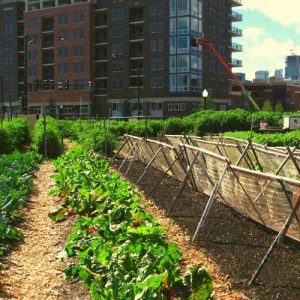Urban Gardening the Deep Bed Method
The deep bed method of urban gardening is labor-intensive but results in more produce when it is time to harvest. Lack of space in an urban garden setting requires more creative ways to produce more crops in less space. This option is gaining in popularity as the movement for city dwellers to grow their own food increases. The yields for deep bed gardens have been carefully studied and shown to produce four times the amount of harvest as the traditional garden.
How to Dig a Deep Bed in an Urban Garden
 The urban gardener must first choose the site of the deep bed. Site selection depends upon sunlight obtained at the site and what plants the gardener wishes to grow. While many plants thrive in less than six to eight hours of sunlight per day, many fruiting plants require that amount to truly be productive. Site selection also depends upon access to the site, as walking on a deep bed should be avoided. This means the gardener needs to reach into the bed to pick produce without actually being in the bed.
The urban gardener must first choose the site of the deep bed. Site selection depends upon sunlight obtained at the site and what plants the gardener wishes to grow. While many plants thrive in less than six to eight hours of sunlight per day, many fruiting plants require that amount to truly be productive. Site selection also depends upon access to the site, as walking on a deep bed should be avoided. This means the gardener needs to reach into the bed to pick produce without actually being in the bed.
Digging a deep bed is labor intensive. Those who wish to go this route must dig at least three feet into the dirt, though the ideal depth is four feet. Since this is so deep, a motorized rototiller is not of much use. Using a shovel, the urban gardener starts by digging one trough the length of the bed. The dirt is to be piled onto the area where the gardener wishes to dig the next trough. The urban gardener digs the long, deep holes filling in the first hole with the excess dirt from the second one. Depending upon the size of the deep bed desired, this can take several hours.
After the digging has been done, seeds or transplants can be planted into the soil at the depth normally recommended for the plants.
Check Out: How to Heal Urban Soil
Plant Spacing for the Deep Bed
 Plant spacing for the deep bed in an urban garden is important to impart the best possible harvest later. Typically, transplants and seeds are to be spaced approximately four times as densely as in a traditional garden. Reasoning for this is because the deep bed is never stepped on, so the soil does not get compacted, inhibiting plant root growth. Plant roots grow straight down into the subsoil as opposed to spreading out as in a typical garden.
Plant spacing for the deep bed in an urban garden is important to impart the best possible harvest later. Typically, transplants and seeds are to be spaced approximately four times as densely as in a traditional garden. Reasoning for this is because the deep bed is never stepped on, so the soil does not get compacted, inhibiting plant root growth. Plant roots grow straight down into the subsoil as opposed to spreading out as in a typical garden.
Seeds or transplants in the deep bed should be sown in a diagonal pattern, as opposed to the straight pattern usually used in a traditional garden. When plants are mature, their leaves should just touch. The urban gardener should use caution not to plant the seeds or transplants too close, as this can foster disease in the grown plants.
Check Out: Laying Out and Planting a Vegetable Garden
Some examples of sowing seed or planting transplants in a deep bed as opposed to a traditional garden bed include peas, which traditionally should be planted about four inches apart. In a deep bed, peas should be planted three inches apart in a diagonal pattern. Beans should be sown in a deep bed four to six inches apart, whereas in a traditional garden, they should be planted in a traditional garden one foot apart with two feet between rows. Carrots should be sown two inches apart in a deep bed and four inches apart in a traditional garden bed.
The deep bed method in urban gardening can be difficult at first but pays heavy dividends later on with less weeding and a lot more produce harvested than in the traditional garden.
The deep bed method of urban gardening is labor-intensive but results in more produce when it is time to harvest. Lack of space in an urban garden setting requires more creative ways to produce more crops in less space. This option is gaining in popularity as the movement for city dwellers to grow their own food increases. The yields for deep bed gardens have been carefully studied and shown to produce four times the amount of harvest as the traditional garden.



Comments are closed, but trackbacks and pingbacks are open.